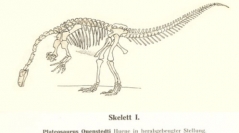

 European Journal of Taxonomy
913 (1) - Pages 1-88
European Journal of Taxonomy
913 (1) - Pages 1-88The genus Plateosaurus is one of the most challenging aspects of early-diverging sauropodomorph taxonomy, with a total of 29 names and a century of revisions. As a result, nomina dubia have been treated as synonyms of Plateosaurus trossingensis, adding to the confusion about the extent of morphological variability. Here, we provide a thorough revision of the taxonomy proposed by von Huene as well as the subsequent taxonomic interpretations of Plateosaurus through a complete inventory of the specimens stored in the Palaeontological Collection of Tübingen. We reassess the status of the specimens in the collection and propose that the sauropodomorph-bearing layers are not necessarily monospecific. Most of the original fieldwork documentation has been lost, but we use the taxonomy established by von Huene as a historical reference point to reconstruct what was known at the time. This revised taxonomy of Plateosaurus narrows the genus to three species: Pl. trossingensis, Pl. longiceps, and Pl. gracilis (as a metataxon), and restricts the genera Gresslyosaurus and Pachysaurus to large and robust individuals, as pragmatic decisions aimed to test their affinities to other Late Triassic sauropodomorphs. Future studies should consider not only morphological variability, but also stratigraphy, palaeogeography, and environmental data when delineating species within and outside the Plateosaurus plexus.
sauropodomorpha, Late Triassic, Trossingen Formation, Löwenstein Formation, Plateosaurus plexus